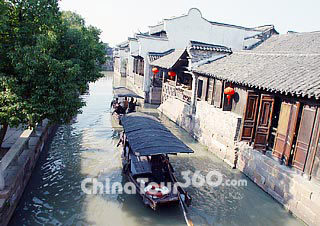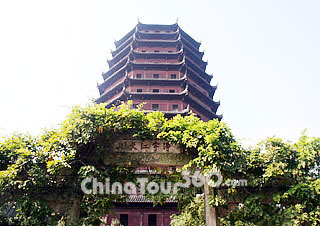 Hangzhou West Lake
Hangzhou West Lake Wuzhen Watertown
Wuzhen Watertown Pagoda of Six Harmonies
Pagoda of Six Harmonies Xitang, Jiaxing
Xitang, Jiaxing
Since ancient times, north Zhejiang and neighboring south Jiangsu have been famed for their prosperity and opulence, and simply inserting north Zhejiang place names into poetry gave an effect of dreaminess, as was indeed done by many famous poets. In particular, the fame of Hangzhou (as well as Suzhou in neighboring Jiangsu province) has led to the popular saying: above there is heaven; below there is Suzhou and Hangzhou, a saying that continues to be a source of pride for the people of these two still prosperous cities.
Zhejiang is located in the southern wing of the Yangtze River Delta on the southeastern coast of China. It borders Fujian to the south, Jiangxi and Anhui to the west, Jiangsu and Shanghai to the north. The word Zhejiang (crooked river) is the old name of the Qiantang River, which passes through Hangzhou, the provincial capital. The name of the province is often abbreviated to 'Zhe'. The province covers a total land area of 101,800 square kilometers (39,305 square miles). The permanent population of the province reached 48.98 million by the end of 2005.
The province possesses varied topography. Hills and mountains account for 70.4 percent of the total area in the province, plains and basins make up 23.2 percent while the rest 6.4 percent is water area composed of rivers and lakes. Zhejiang also boasts a coastline totaling 6,486 kilometers (4,030 miles), the longest for a single province in the country. In addition, the province has the largest number of islands and isles in China, and among them there are 3,061 islands and islets that have an area of more than 500 square kilometers (193 sq mi) each.
Lying in a subtropical zone of monsoon climate, the province is blessed with abundant sunshine, ample rainfall in four distinct seasons. The average annual temperature is 15 to 18 degrees Celsius (59 to 64.4 degrees Fahrenheit) and the average annual precipitation is 1,200 to 1,800 millimeters (47.2 to 70.9 inches). There is plenty of rainfall in early summer, and by late summer Zhejiang is directly threatened by typhoons forming in the Pacific.
Zhejiang is renowned for its picturesque landscapes. In the province, there are mountain ranges rising and falling, plains crisscrossing, rivers flowing long distance and islands scattering all over like stars in the sky. The mountains, rivers, lakes, sea, beaches, forests, caves and fountains form beautiful sceneries running together. The extraordinary mountains and rivers have fostered generations of outstanding figures and attracted guests from all sides, leaving human historic sites all over Zhejiang.
Thanks to her long history, splendid culture, uniquely favorable natural environment, Zhejiang is worthy of compliments such as 'a region of fish and rice, the home of silk, a paradise for tourists and a land of rich cultural heritage', which have been lavished upon her since ancient times.
![]() Recommended Zhejiang Tour Itineraries:
Recommended Zhejiang Tour Itineraries:
East China Tour with Hangzhou: 13-Day of Shanghai - Huangshan - Suzhou - Zhouzhuang - Suzhou - Hangzhou - Beijing
Shanghai Surrounding Tour with Hangzhou: 6-Day of Hangzhou - Suzhou - Wuxi - Nanjing







